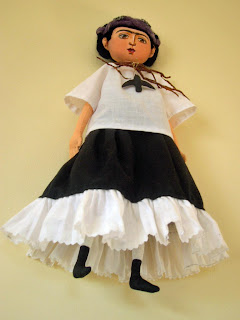 |
| Self portrait with thorn necklace and dead hummingbird/Autorretrato con collar de espinas y colibri muerto Frida Kalho, 1940 |
This painting is very impressing, it talks about Frida facing divorce, loneliness, and physical pain; later she remarried Diego Rivera in December 1940. Also is one of very few where she paints herself in frontal position, most of her paintings are three quarter portraits.
La pintura es impresionante, nos habla de una Frida sola, divorciada, llena de dolor fisico; poco despues, en diciembre de 1940 volvio a casarse con Diego Rivera. Esta es una de las pocas ocasiones en las que se pinta de frente, la mayoria de sus retratos fueron ejecutados en posicion de tres cuartos.
It was quite a challenge to paint such a strong frontal portrait, once I was finished I remember telling myself how sad this particular doll seemed to be, compared to the others. For this portrait Frida did not focus on painting embroidered blouses, but in the intricacy of the thorn necklace.
Fue un gran desafio pintar un retrato frontal de sentimiento tan fuerte, una vez que termine y la vi junto con las demas munecas, oi decirme a mi misma lo triste que se veia esta muneca. En este retrato Frida no se intereso en pintar una blusa bordada, sino en la minucia del collar de espinas.
This is the thorn necklace before it was wrapped around Frida’s neck, it was made of twine, modelling paste and acrylic paint. In the painting looks too thight, it seems to choke Frida, for the doll I made something more moderate.
Este es el collar de espinas antes de que se lo pusiera a Frida, esta hecho de cuerda, pasta para modelar y pintura acrilica. En la pintura se ve muy apretado, casi a punto del extrangulamiento, para la muneca decidi hacer algo mas moderado.
The black hummingbird is made of paper clay and painted with acrylics. In Mexico the hummingbird stands for love, single people go to the markets to get stuffed hummingbirds, and believe the bird will bring them love, the folk name for such an item is “chupamirto”. Nowadays this tradition is almost extinct (good news for the hummingbirds, of course). In Frida’s case, the black hummingbird stand for a dead love.
El colibri negro esta hecho de arcilla de papel, pintado con acrilicos. En Mexico el colibri tiene el significado de amor, la gente soltera solia ir a los mercados y comprar colibries disecados con el proposito de encontrar pareja(s), a tales amuletos se les llamaba “chupamirtos”, hoy en dia la tradicion esta casi extinta (buenas noticias para los colibries por supuesto). En el caso de Frida el colibri negro significa un amor muerto.
The hairdo is something to look at, it is the traditional Aztec style, still used in the Tehuantepec Isthmus today. This is kind of weird, because the native population over there is Zapotec, although they shared things in common like fashion. The brooches on Frida’s braids are silver butterflies, she had a pair like that in her collection.
El peinado es muy detallado, es el estilo original de las mujeres Aztecas, aun usado en el Itsmo de Tehuantepec, esto es medio raro porque la poblacion nativa de la region es Zapoteca, aun asi ambas culturas compartian cosas en comun, sobre todo en el atuendo. Los prendedores en las trenzas de Frida eran mariposas de plata, la pintora tuvo un par asi en su coleccion de joyeria.
Frida with whole outfit, her simplicity only adds more beauty to the overal figure. I omitted the monkey and cat that appear in the painting because they are behind the artist, without any contact with her, acting like shadows of her sorrow, I though she had enough already!
Frida con su atuendo completo, la simpleza de la vestimenta solo le anade belleza a la figura, decidi no hacer el mono ni el gato porque se encuentran atras de la artista, no entran en real contacto con ella, solo son espectadores de su dolor, creo que Frida ya habia tenido demasiado!
Thanks for visiting, I wish you enjoyed our trip through the painting and the doll making process. Next time you are welcome to meet: “Self portrait as Tehuana”
Gracias por acompanarme, espero que hallan disfrutado el viaje de la pintura y la confeccion de la muneca. La proxima vez les presentare: “Autorretrato como Tehuana”








